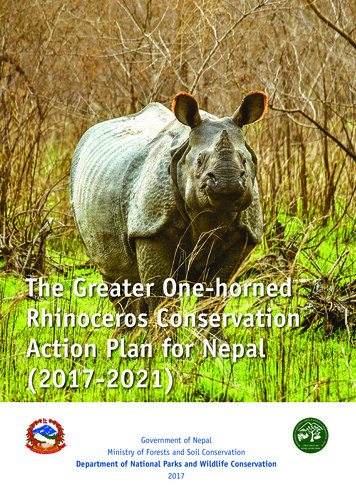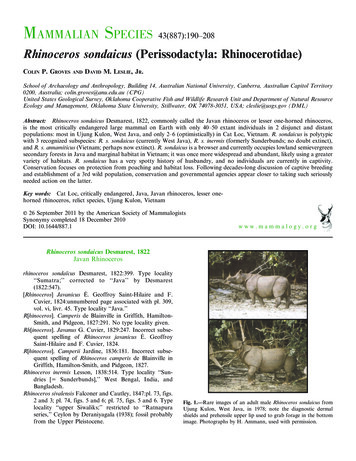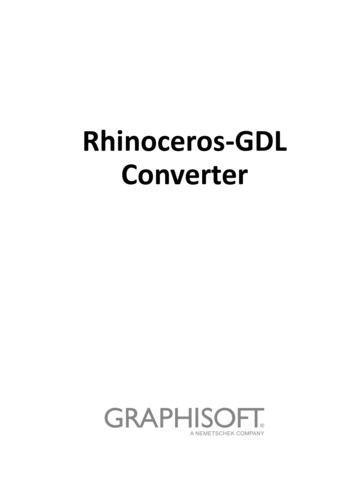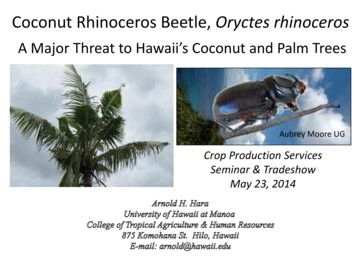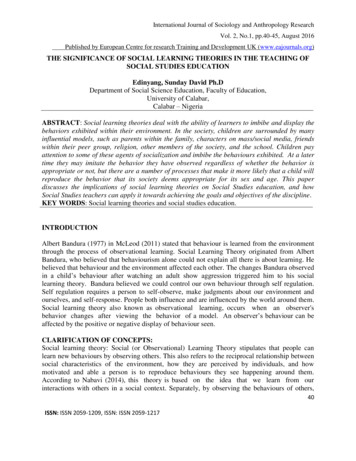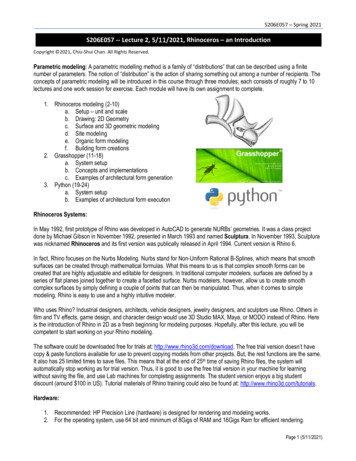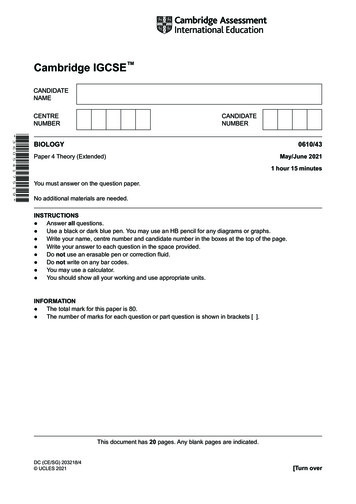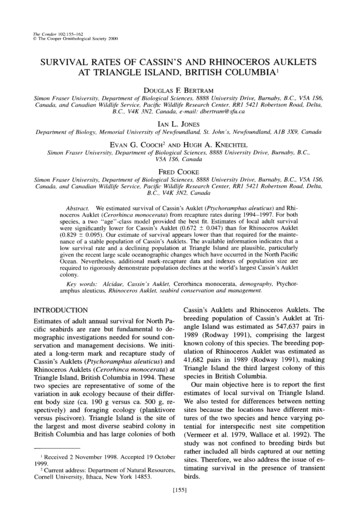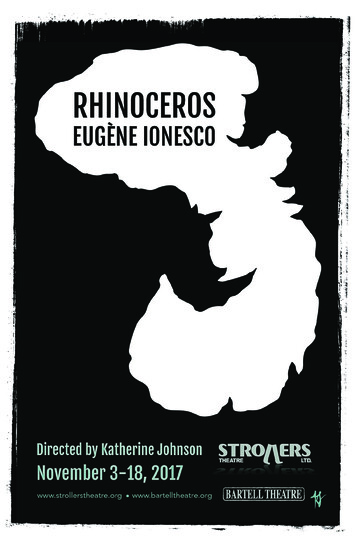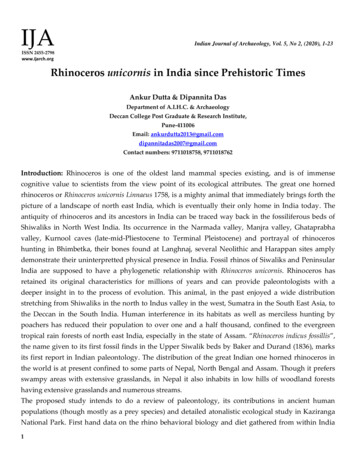
Transcription
IJAIndian Journal of Archaeology, Vol. 5, No 2, (2020), 1-23ISSN 2455-2798www.ijarch.orgRhinoceros unicornis in India since Prehistoric TimesAnkur Dutta & Dipannita DasDepartment of A.I.H.C. & ArchaeologyDeccan College Post Graduate & Research Institute,Pune-411006Email: Contact numbers: 9711018758, 9711018762Introduction: Rhinoceros is one of the oldest land mammal species existing, and is of immensecognitive value to scientists from the view point of its ecological attributes. The great one hornedrhinoceros or Rhinoceros unicornis Linnaeus 1758, is a mighty animal that immediately brings forth thepicture of a landscape of north east India, which is eventually their only home in India today. Theantiquity of rhinoceros and its ancestors in India can be traced way back in the fossiliferous beds ofShiwaliks in North West India. Its occurrence in the Narmada valley, Manjra valley, Ghataprabhavalley, Kurnool caves (late-mid-Pliestocene to Terminal Pleistocene) and portrayal of rhinoceroshunting in Bhimbetka, their bones found at Langhnaj, several Neolithic and Harappan sites amplydemonstrate their uninterpretted physical presence in India. Fossil rhinos of Siwaliks and PeninsularIndia are supposed to have a phylogenetic relationship with Rhinoceros unicornis. Rhinoceros hasretained its original characteristics for millions of years and can provide paleontologists with adeeper insight in to the process of evolution. This animal, in the past enjoyed a wide distributionstretching from Shiwaliks in the north to Indus valley in the west, Sumatra in the South East Asia, tothe Deccan in the South India. Human interference in its habitats as well as merciless hunting bypoachers has reduced their population to over one and a half thousand, confined to the evergreentropical rain forests of north east India, especially in the state of Assam. “Rhinoceros indicus fossillis”,the name given to its first fossil finds in the Upper Siwalik beds by Baker and Durand (1836), marksits first report in Indian paleontology. The distribution of the great Indian one horned rhinoceros inthe world is at present confined to some parts of Nepal, North Bengal and Assam. Though it prefersswampy areas with extensive grasslands, in Nepal it also inhabits in low hills of woodland forestshaving extensive grasslands and numerous streams.The proposed study intends to do a review of paleontology, its contributions in ancient humanpopulations (though mostly as a prey species) and detailed atonalistic ecological study in KazirangaNational Park. First hand data on the rhino behavioral biology and diet gathered from within India1
Rhinoceros unicornis in India since Prehistoric Timeswill be a native source material for analogy as well as palaeological interpretations for futureresearchers of rhinoceros. This endeavor is aimed at making fresh first hand data which sets forfuture studies if similar evidence from fossil record is collected. The research includes almost entirelife system of the great one horned rhinoceros including his past distribution in India. The researchmethodology has been structured in three parts such as the reference work, field work (Actualisticstudies) and synthesis and review of archaeological and fossil record.Study Area: Kaziranga National Park is the most populated area of present day one hornedrhinoceros. It is situated in Golaghat District of Assam, on the south bank of the river Brahmaputra(Map no. 1 & 2 and Table no. 1). It was first established as a sanctuary in 1908, on the initiative ofLady Curzon and attained the status as a National Park in 1974. It provides a natural habitat for anumber of rare, threatened and interesting species. A symbol of dedication for the conservation ofanimals and their habitat, Kaziranga with a National Park status represents the single largestprotected area within the Northeast Brahmaputra valley.Map No. 1: Map of Assam showing the course of Brahmaputra and highlighting ideal ecological locations that enablerhino prolification2
Indian Journal of ArchaeologyMap No. 2: Map of Kaziranga National Park indication its forest rangesArea of Kaziranga430 sq. kmElevation80 metre (262 feet)Coordinates26 40’00’’ N93 21’00’’ EClimateSummer: 37 c (99 F)Winter:Location5 c (41 F)271 km, east of GuwahatiTable No. 1: Table indicating the area, elevation, coordinates climate and location of Kaziranga National ParkThe rhinoceros is a solitary animal and territory has not been representated. The association of twoanimals is confined to mother and calf or two mating rhinos. During the pre-monsoon season manyrhinos have been seen in the same wallow. During the night they sleep in the dry grounds. Duringwinters, wallowing activities are markedly reduced and they graze for long hours both in themorning and evening. The rhinos make their stay around such wallows and move to the nearby areas3
Rhinoceros unicornis in India since Prehistoric Timesfor feeding. Normally they do not migrate for long distances. Only during flood, they are forced toseek shelter away from their normal areas. The rhinos have a peculiar habit of defecating in regulardung heaps. The dung heap can be used by more than one rhino for a given period of time. Anotherhabit of rhino is that it always uses well laid out tracks from its wallowing place to the feedinggrounds and vice versa while roaming in the grassland. The present study focusses on detailedreview and also includes some of the recent methodological innovations (viz. Trails and track waysand dung analysis)Taxonomy: All the five existing specie of rhinoceros are grouped in a single family, Rhinocerotidae.They are massive, graviportal, pachyderms (hoofed nonruminants, characterized by thick, solidbones and short, stumpy legs. The limbs are broad and massive and are padded with elasticconnective tissues designed to bear their weight. The sheer size of animals makes them free fromnatural predation except in the calf stage. Though belonging to one family and possessing the broadcharacteristics of that family, the five existing species of rhinoceros differ from each other in diverseways. As a result of adaptation to different environment, the extant species became distinct from eachother at very early stage in their evolutionary history. A group of rhinos is called a crash. All thespecies of rhinoceros have 82 chromosomes (diploid number, 2N, per cell), except the BlackRhinoceros, which has 84. This is the highest known chromosome number of all mammals.Geological factors, climatic changes as well as biotic factors have ensured that most of the severaldozen genera of the family Rhinocerotidae have become extinct. At present there are only five livingspecies distributed in four genera in the world, two in Southern and Eastern Africa and three intropical Asia. All five extant species today are also declared endangered (Fig. 01).The extant Rhinoceros species are:1. The African White or Square Lipped Rhinoceros (Ceratotherium simum)2. The African Black Rhinoceros (Diceros bicornis)3. The Asiatic Two Horned or Sumatran Rhonoceros (Dicermocerus or Dicerorhinussumatrensis)4. The One Horned or Javan Rhinoceros (Rhinoceros sondaicus)5. The Great Indian One Horned Rhinoceros (Rhinoceros unicornis)4
Indian Journal of ArchaeologyFig. No. 1: The five species of Rhinos in the worldRhino in Antiquity: Its Palaeontological and Archaeological Record: Rhinoceros have been roamingupon the earth for more than 60 million years. Their fossil history is somewhat convoluted. They arebelieved to have evolved from the early tapiroids, but took a different evolutionary route. Fossils andother palaeo-zoological remnants reveal that the ancestors of the family Rhinocerotidae firstappeared during this period. Prehistoric rhinoceros species began to be recognizable towards the endof the Eocene. Fossil remains in the Shiwalik Hills show that the Sumatran rhinos existed in Indiaduring Pliocene. In India the Rhinoceros made its first appearance in the Eocene. Apart from sixspecies of rhinoceros, fossilized remains found in Upper Siwalik beds reveal remarkable mammaliandiversity in the region during Plio-Pleistocene period.The progress of the Cenozoic era saw several dozen genera that can be said to belong to theRhinocerotidae family. The largest among these in the past were the Baluchitherium gangeri andIndicotherium in the Oligocene and Miocene (25 million years ago) epochs. They were denizens ofAsia, and were perhaps the largest terrestrial mammals ever known. The Rhinoceros therefore wascommon in North America in the Tertiary period and probably died out there during Pliocene (10million years ago). But in Eurasia many different species survived right up till the Quaternary period,become extinct only in the Pliestocene (1 million years ago). Large horns were a prominentcharacteristic of rhinoceros in the Pliocene epoch. In Pleistocene there was the Ceolondonta, or woolyrhinoceros whose bones have been found in almost intact form in caves and river beds from the5
Rhinoceros unicornis in India since Prehistoric TimesBritish Isles across Eurasia to China. The coelondonta has been immortalized by Stone Age artists incave paintings.S. No. Rhinoceros sivalensisRhinoceros unicornis RhinocerosRhinoceros indicusRhinoceros javanicusLarge and robustSmaller and lighter1Large2Nasals expanded into large Deeprounded horn boss34sondaicussaddleinthe Shallow saddle in the cranialcranial profileDeep saddle in the cranial Deepsaddleprofilecranial profileOcciput forwardly inclinedOcciput profileinthe Shallow saddle in the cranialprofilehighand Occiput low and broadnarrow5Skull considerably deepSkull deepSkull comparatively shallow6Ectoloph of cheek teeth flatEctoloph of cheek teeth Ectolophflat7Parastyle butress presentParastyleofcheekteethsinuousbuttress Parastyle buttress prominentsuppressed8Well-developedcrochet Well-developed crochet Crochet present but cristaand indistinct cristaand cristagenerally absent9Teeth hypsodontTeeth sub-hypsodontTeethless- hypsodont10Premaxillaries broadPremaxillaries broadPremaxillaries narrowTable No. 2: Comparison of characters of three species1The great Indian one horned rhinoceros, which once roamed in great numbers throughout the IndoGangetic plains and the Brahmaputra valley, survives in few places in Assam, West Bengal andNepal. Their survival is precarious, and yet providing encouraging figures in Assam and Bengaltoday:AssamKaziranga National Park1,400West BengalJaldapara Sanctuary30NepalChitawan National Park400Indian rhino in archaeological record: Rhinoceros, for virtue of being an aggressive and large beasthas evoked a response that has either driven early man away from it for safety or confrontation withhunting as an inevitable reaction. Prehistoric rock art offers rhino-human encounters where huntingor an attempt of hunting provides a direct evidence of rhino presence especially when their fossil6
Indian Journal of Archaeologyrecord gets patchy in archaeological assemblages towards the end of Terminal Pleistocene. A closesuvey of published archaeofaunal records reveal that rhinoceros has had a distribution throughoutthe length and breadth of Indian Sub-continent until historic times, rhino has not so far been reportedfrom any Iron Age and early historic sites of India. Skeletal remains of several protohistoric sites isagain a reminder that it was an important animal at a site whose exploitation was driven by primaryproducts. For e.g.: Rhino bones as part of ‘use assemblage ‘comes from Langhnaj.Skeletal records of rhino has been reported from Neolicthic, Indus valley and Chalcolithic sites inIndian subcontinent. Prehistoric rock art mostly from Central India offers rhino-human encounterswhere hunting provides a direct evidence of rhino presence especially when their fossil record getspatchy in the archaeological assemblages towards the end of Terminal Pleistocene. The excavations atMohenjadaro yielded a seal (Fig. 02) bearing the figure of a one horned rhino. It indicates the regionthen was green and fertile. The Fifth Pillar Edict of Ashoka, the Great in 3rd century B.C also mentionsthe Indian Rhino which enumerates the animals that were to be preserved.From ancient times the Indian rhino was a favourite game for hunters who saw in its intimidatingappearance and size vindication of their own process as hunters. As early as 1398 Timur Beg huntedthe animal on the frontiers of Kashmir. In 1519 the Emperor Babur hunted rhino in Peshawar andbank of the river Sorju (Ghagra) in North India. In the book of Sidi Ali is mentioned the sighting ofrhino near Kothal pass, west of Peshawar in 1554. Abul Fazl states that rhinoceros could be seen inSambal Sarkar of Delhi during the reign of Akbar. Shrinking of home range of rhino is primarilyattributed to climatic change and hunting by man in the recent history of humanity. Supposedmedical properties of the horn and its mythological associations have been detrimental to its survival,but its antiquity may be pushed to several hundred years.7
Rhinoceros unicornis in India since Prehistoric ndicasRhinocerosunicornisRhinoceros Rhinoceroskernuliensis deccanensisSiwaliks Narmada Godavari Manjra Kurnool Ghatprabha valley 1905Sathe,20052Lydekker,1886Foote 1876Table No. 3: Occurrence of rhino fossils in quaternary fossil sites of IndiaUpper Paleaolithic site:Scientific nameSiteRhinoceros kernuliensisKurnool cavesTable No. 4: Occurrence of rhino in Upper Paleolithic site3Mesolithic sites:Scientific nameSiteRhinoceros unicornisLanghnajRhinoceros unicornisKanewalRhinoceros unicornisRhinoceros unicornisDamdamaBhimbetkaTable No. 5: Occurrence of rhino in Mesolithic sites48
Indian Journal of ArchaeologyMap No. 3: Indicating the occurrence of rhino in Upper Palaeolithic and Mesolithic sites in IndiaHarappan sites:Scientific nameRhinoceros unicornisRhinoceros unicornisRhinoceros unicornisRhinoceros unicornisRhinoceros tada
Rhinoceros unicornis in India since Prehistoric TimesSpecies doubtfulRhinoceros unicornisRhinoceros unicornisOrio TimboKhanpurShikarpurTable No. 6: Occurrence of rhino in the Harappan sites5Fig No. 2: Seal bearing Rhino image found in Mohenjadaro 610
Indian Journal of ArchaeologyMap No. 4: Indicating the occurrence of one-horned rhino in the Harappan sites in IndiaChalcolithic sites:Scientific nameSiteRhinoceros unicornisNevasaSpecies doubtfulInamgaonTable No. 7: Occurrence of rhino in the Chalcolithic sites of India 711
Rhinoceros unicornis in India since Prehistoric TimesMap No. 5: Indicating the occurence of rhino in Chalcolithic sites of IndiaThe Neolithic site (Northern and Eastern India):Scientific nameSiteReferencesRhinoceros unicornisChirandNath and Biswas, 1990Table No. 8: Occurrence of rhino in the Neolithic sites of India 812
Indian Journal of ArchaeologyMap No. 6: Northern and Eastern Indian Neolithic sites occurring rhinoHowever Rhino has not so far been reported from Iron Age and early historic sites of India. Thefertile plains and the grassy areas, ideal as rhino habitats, unfortunately were equally ideal forcultivation. So with an increase in population such areas were taken over by man, and the rhinohabitat was irrevocably destroyed in these regions.13
Rhinoceros unicornis in India since Prehistoric TimesFig. No. 3: Rock painting showing rhinoceros unicornis in Bhimbetka rock shelterDung Analysis of Living Rhino: “Coprolite” is a scientific name for the fossilized excrement, faces ordroppings of ancient animals. They form an important class of objects studied in the field ofarchaeology. The recognition of coprolites is added by their structural pattern, such as spiral orannual markings, their content, such as undigested food fragments and also by associated fossilremains. In past it might have been sufficient for an archaeologist to excavate a site and later reporthis finds solely in terms of ceramic, lithic and fibrous artifacts. However today, one tries to speculateupon aspects such as animals butchering techniques, seasonal uses of a site, subsistence pattern,palaeo environmental conditions or methods of artifacts manufacture. One such item which has onlyrecently been saved with a degree of regularity during the excavation of archaeological sites iscoprolites.We chose to collect several samples of rhino dung using GPS for defining dropping locations, rhinomovements and home range of individual rhinos in Kaziranga National Park. It is essentiallyintended to highlight the importance of such research methods in Indian context besides preparingvegetational profile of rhinos in Assam during winter. Since rhino fossils have been reported fromseveral Pleistocene fossil sites in India, it is imperative that detailed vegetational and dietary profileof living rhinos is also prepared through dung specimens so that it could be used as analogicalevidence for palaeoecological reconstruction. Existing methods of wildlife research focus on tracing14
Indian Journal of Archaeologyanimal movements in different areas at different times but dung analysis is not yet considered aviable means of analyses. Hence it is being shown here that data pertaining to behavioral ecologyavailable through pioneering researches on living rhinos, needs to be complimented by examining itsdung specimens so that it could provide multiple lines of interpretations to augment a better pictureof past ecology where these creatures lived and perished in slice of time.Rhinos have a peculiar habit of revealing the droppings. Each heap denotes that of an individual for amonth and after which he would choose another location for this activity. Hence it became possible toidentify these droppings of five different individuals, thereby providing dietary profile of fivedifferent individuals. We collected five samples (R1, R2, R3, R4 and R5) of dung of Rhinocerosunicornis from different places of Kaziranga National Park to study the pollen profile, therebyidentifying as to what type of vegetation was consumed by these individuals.Fig. No. 4: Rhino dung (accumulation of over a month)15
Rhinoceros unicornis in India since Prehistoric TimesFig. No. 5: Another heap of rhino dung16
Indian Journal of ArchaeologyPollen Results after samplingFig. No. 6: Slide showing pollen FabaceaeFig. No. 8: Slide showing pollen AsteraceaeFig. No. 10: Slide showing pollen Poaceae17Fig. No. 7: Slide showing pollen AmaranthaceaeFig. No. 9: Slide showing pollen EuphorbiaceaeFig. No. 11: Slide showing pollen Poaceae
Rhinoceros unicornis in India since Prehistoric TimesName of the IndividualQuadrentsPollen ProfileR1N 26 38.8’47’’E 93 31.3’52’’R2N 26 38’909’’E 93 21’895’’N 26 37’126’’E 93 18’604’’N 26 41’320’’E 93 33’930’’N 26 40’145’’E 93 25’708’’Mytraceae,Poaceae,Euphorbiaceae, Amarantaceae,Cyperaceae, fungal Amarantaceae,Hamiaceae,Euphorbiaceae, Euphorbiaceae,Cyperaceae, FabaceaeTable No. 9: Showing the pollen resultsResults:All these palynomorphs are typical indicators of wet moist environmental conditions. Particularly thefamilies like, Poaceae, Cyperacea, Fabaceae, Myrtaceae etc. Such direct ecological affinities. Poaceae isabundant in the sample followed by Cyperaceae, Fabaceae, Amarantaceae, Euphorbiaceae etc.Poaceae and Fabaceae are generally used as fodder by these animals. Ocassionally Hamiaveae,Euphorbiaceae, herbaceous species are also seen. Overall diet suggest that these animals only preferPoaceae, Cyperaceae, Fabaceae and few other herbaceous species. The diet is restricted to few speciesonly.Focus on the track ways of rhinos in Kaziranga National ParkTrace Fossils (or ichnofossils) are the biogenetic sedimentary structures that record biologicalactivities such as burrowing, walking and feeding. As sedimentary structures, trace fossils are usuallypreserved insitu and are more accurate and reliable indicators of the sedimentary environment thanbody fossils, which are subject to postmortem transport. Assemblages of trace fossil form stablegrouping that are widely used in the reconstruction of palaeo - environment. However, therelationship between the fossil species and the trace fossil is complex and there is no complex orsimple correlation between species, activity and traces.The simplest use to watch traces can be put in determining way-up in a sequence of rock. Most tracesin soft sediment consist of depressions pressed or excavated by the passage of an animal, can be usedin just the same way as flute marks, tool marks and flame structures. Trace fossils can even be used todeduce what kind of organism made it, and can lead to quite precise predictions by deductive18
Indian Journal of Archaeologyreasoning. Several organisms have been proposed and named on the evidence of trace fossils alone. Itcan also complete the picture of a vanished fauna by telling the paleontologists about the soft-bodiedanimals which helped compose it. Track ways provide direct clues to size and locomotion of theanimal and how it progressed for several consecutive steps.Through this research we hope that the study of foot prints of Rhinoceros unicornis will certainly helpthe future paleontologists to recognize the footprints of Rhinoceros unicornis, their locomotion, theirbehavioral pattern etc. in the archaeological field by comparing the fresh rhinoceros track ways.Findings of prints of rhino at the fringes of lakes at Bagori, Kohora and Agaratoli forest rangesreveals that all of them indicating rhino’s movements towards water body for consumption atdifferent times in a day. The tracks are a cluster of prints of young and adult rhinos, elephants, wildbuffalos and deer species in moist sediments along the beels at Kaziranga. Documentation wasconfined only to a few lakes with detailed measurements of individual prints, gradient of the printbearing horizon. Documentation of detailed rhino movements to and from water body were noticedwhere the intra and inter - individual sole size becomes an interesting contribution to the complexstudy of ichno fossils. There were no prints indicating a mixed cluster of only rhinos but acombination of elephants, rhinos, wild buffalos and few deer species. The fact that all these animalshad a common objective of consuming water, these prints may appear to be the signatures of theirmovements for such an obvious activity. However, the underline information as to how many ofthem visited in a day, what might have been the ratio of visiting male, female and calf in a day aswell as what behavioral traits of rhino and other track makers can be studied are few lines ofarguments, central to the study to highlight large mammalian behavior in a natural set up likeKaziranga. However, keeping in view a few practical constraints (high resolution 3D Photographicequipment's, inhospitable wildlife) documentation was confined only to a few lakes with detailedmeasurements of individual prints, gradient of the print bearing horizon and systematicdocumentation of prints of rhino, elephants, buffalo and deer for future analysis. Footprints wereprepared for these animals so that a catalogue could be brought out for its exhaustive application infuture paleontological sites. It also provided data to understand the rhino movements to and fromwater body where the intra and inter - individual sole size becomes an interesting contribution to thecomplex study of ichno fossils.Individual1st individual2nd individual3rd individual4th individual5th individual19Foot length (cm)2930333028Foot breath (cm)2427262725
Rhinoceros unicornis in India since Prehistoric Times6th individual (of a baby ofabout 5-7 years old)7th individual8th individual9th individual10th individual11th individual12th individual13th individual25223028292828293028272423222425Table No. 10: Measurements of footprints of 13 individuals of rhino from Kaziranga National ParkFig. No. 12: Footprints of Rhinoceros unicornis in Kaziranga20
Indian Journal of ArchaeologyFig. No. 13: Rhino footprint at KazirangaFig. No. 14: Shape of the foot printFig. No. 15: Cluster of footprints of Rhinoceros unicornis in Kaziranga21
Rhinoceros unicornis in India since Prehistoric TimesFig No. 16: Clusters of footprints of rhino in the bank of the beel (lake) at KazirangaConclusion: The present research is a detailed review which includes some of the recentmethodological innovations (viz. Trails and trackways, and dung analysis) which are very significantpiece of documentation that can be treated as a beginner’s catalogue for analogical studies in palaeo zoology. The authors have tried to include almost entire life system of the great Indian One HornedRhinoceros including his past distribution in India depending on various archaeological sources. Asmentioned earlier one of the significant attempts in this work is the study of the track ways of thisanimal in its present day home range in Kaziranga National Park. Till date no one has attempted towork on Rhinoceros unicornis in Kaziranga through Paleontological aspects. Hence an evolutionary,ecological and subsistence perspective of rhinoceros in Indian archaeology with special reference toecology of living rhinos is proposed in present research. Data pertaining to behavioral ecologyavailable through pioneering researches on living rhinos, needs to be complimented by examining itsdung specimens so that it could provide multiple lines of interpretations to augment a better pictureof past ecology where these creatures lived and perished in slice of time.The present study includes rhino taxonomy, present day distribution with special reference to onehorned rhinoceros in Indian subcontinent, origin and early history, human response to rhino duringproto-historic times, ecology, behavioral aspect seen through tracks and trails, dung analysis and an22
Indian Journal of Archaeologyupdate on the status of rhino population in its only abode in India i.e., Kaziranga National Park inAssam.A maiden approach towards documentation of fresh foot prints of several living rhinos in Kaziranga.The study of foot prints of rhino has been helpful in preparing a set of type specimens of rhinolocomotion. To prepare a profile of foot impressions of different age and sex of rhino as a referencematerial for future studies. So far, no such trace fossils have been discovered in Indian Pleistocene,but in the event of their discovery from one of those several fossil localities may receive major inputsfrom this present reference collection. For the first time, the study of track ways of Rhinocerosunicornis has been documented in different sedimentary environment. The research will certainlyhelp the future paleontologists to recognize the footprints of Rhinoceros unicornis, their locomotion,their behavioral pattern etc., in the archaeological field by comparing the fresh rhinoceros track ways.Likewise preparation of analogical record of dung specimens is always a necessity that can berewarding. Dung specimens of rhinos were collected from Kaziranga National Park and wereanalyzed for pollen identification. Interestingly, the identification has however, remained to family ora genus level but that throws adequate light on what type of flora has been consumed by those fiveindividuals as well as what flora might have been an intrusive species. This can be the points ofbeginning of research in the field of rhino palaeozology having great potential in reconstructingdietary behavior by identifying types of flora in different seasons of the year in present day rhinopopulation.References:1.Badam, G. L. 1979. Pleistocene Fauna of India with special reference to the Siwaliks. Pune.Kirloskar Press.2.Sathe, Vijay. Contents of Faunal Assemblages and changed Perspectives. Paper presented at Biennid conferenceof European association of South Asian Archaeologists, British Museum, London (U.K) from 4 th to 8th July 2005.233.Thomas P.K. & Joglekar, P.P. 1994. Holocene faunal Studies in India, Man and Environment, pp. 179-180.4.Ibid.5.Ibid.6.Dutta, Arup Kumar. 1991. Unicornis: The Great Indian One Horned Rhinoceros. Delhi: Konark Publishers.7.Thomas P.K. & Joglekar, P.P. Opcit. 1994.8.Ibid.
5. The Great Indian One Horned Rhinoceros (Rhinoceros unicornis) Indian Journal of Archaeology 5 Fig. No. 1: The five species of Rhinos in the world Rhino in Antiquity: Its Palaeontological and Archaeological Record: Rhinoceros have been roaming upon the earth for more than 60 mi
